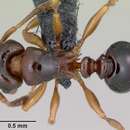en
names in breadcrumbs


Taxonomic history
Emery, 1899e PDF: 285 (q.).Combination in Xiphomyrmex: Emery, 1899e PDF: 285.Combination in Tetramorium: Bolton, 1979 PDF: 142.Senior synonym of Tetramorium humbloti pembensis: Bolton, 1980 PDF: 228.Senior synonym of Tetramorium humbloti victoriensis: Bolton, 1980 PDF: 228.See also: Hita Garcia et al., 2010b PDF: 72; Hita Garcia & Fisher, 2012a PDF: 118.Fundnotiz: Gross-Comoro.
Das Tetramorium (Xiphomyrmex) Weitzeckeri Emery (1894) scheint mir fast nur eine extreme afrikanische Rasse des Humbloti zu sein. Emery vergleicht es mit Bessoni , dessen Thorax nicht gerandet und dessen Knoten dicker sind. Das sind aber gerade diejenigen Merkmale, die Humbloti von Bessoni unterscheiden. Der [[ worker ]] von Weitzaekeri unterscheidet sich von Humbloti nur durch seine bedeutendere Groesse, sowie durch die geringere Woelbung und die viel staerkere Skulptur des Thorax. Das [[ queen ]] von Weitzaekeri ist dem [[ queen ]] von Humbloti identisch, nur groesser (auch die Skulptur identisch).
Tetramorium {Xiphomyrmex) humbloti Forel , 1891 a: 154, pl. 4, fig. 12. Syntype workers, Comoro Is.: Grand Comoro I., Ngasiya (L. Humblot) (MHN, Geneva) [examined].
Worker. TL 3.4 - 4.1, HL 0.80 - 0.94, HW 0.74 - 0.88, CI 92 - 95, SL 0.56 - 0.72, SI 74 - 84, PW 0.54 - 0.66, AL 0.88 - 1.08 (30 measured).
Mandibles finely longitudinally striate. Antennal scrobes represented by an impressed area bounded above by the frontal carinae but without a differentiated ventral margin. Alitrunk in profile with the propodeum sloping downwards strongly from the metanotal groove to the base of the stout, acute spines. Metapleural lobes acutely triangular and generally slightly upcurved. Both petiole and postpetiole strongly anteroposteriorly compressed, in profile narrow and much higher than the dorsum is long, in dorsal view markedly transverse, much broader than long, in general form similar to that of bessoni , Fig. 9. Head strongly longitudinally rugulose, often with cross-meshes and always with the spaces between the rugulae reticulate-punctate. Dorsal alitrunk unsculptured or at most with some weak punctulation on the pro- or mesonotum. Pedicel segments and gaster unsculptured. Head with sparse, fine, erect hairs. Alitrunk and pedicel usually without hairs but rarely with 2 - 6 hairs present on the former. First gastral tergite always without hairs, but remaining tergites with them. Colour varying from light to dark brown, the gaster sometimes darker in shade than the alitrunk.
T. humbloti is an African species which has extended its range to include the Comoro Islands, but has not yet been discovered on the mainland of Madagascar. In Madagascar is a sibling of humbloti , T. bessoni , which has the head consistently less strongly sculptured and also tends to be more densely hairy than humbloti . Details for their separation are noted in the key.
As noted above, humbloti really belongs to the Ethiopian region fauna, and the description is based mainly upon such material. Discussion of the synonymy and distribution of humbloti is not given here as it will be dealt with in the part of this study dealing with the Ethiopian region.